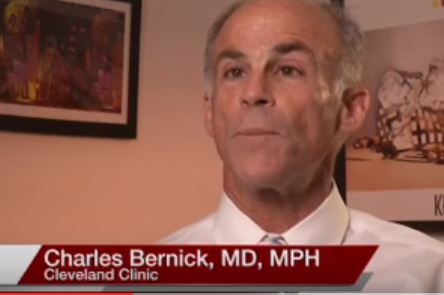Charles Bernick, M.D, MPH, Associate Director of the Cleveland Clinic Lou Ruvo Center for Brain health talks about head trauma and chronic traumatic encephalopathy in combat sports.
Interview conducted by Ivanhoe Broadcast News in May 2016.
Tell me about the study with the boxers and MRI.
Dr. Bernick: About six or seven years ago when there was more attention that was being devoted to long term effects of head trauma, primarily from football players, there became more recognition of a condition called chronic traumatic encephalopathy which we believe is a neurodegenerative condition similar to Alzheimer’s and Parkinson’s. And here in Las Vegas, we’re the fight capital of the world; we have really good relationships with other folks in the combat industry field; our Nevada Athletic Commission is one of the most progressive in the country; we thought we had just a great opportunity to really try to understand how CTE developed, what are the risk factors, how can we diagnose it early and of course eventually how do we prevent it. We launched the study, the Professional Fighters Brain Health Study, in 2011. And the goal of the study is to do just that: to be able to detect changes in the brain from head trauma early, be able to detect subtle changes, to be able to understand why some individuals who are exposed to head trauma develop long term symptoms and some not, which we know is true, and eventually to be able to intervene and either improve the safety of these sports and folks that are exposed to head trauma in the military and eventually develop treatments.
What have you found in the last four years?
Dr. Bernick: We found actually quite a bit. We know that there are specific areas of the brain that seem to be vulnerable to injury. We can actually track change over time in looking in these areas of the brain. The volume and the size of these areas can change over time. The fibers that run through these areas change over time in certain individuals. When we see these changes in the volume and the fibers we also see changes in how these people perform on tests of processing speed, of their mental acuity, of their reaction time. We seem to believe that there’s a correlation between what we’re seeing and how somebody is performing.
Any surprises, what’s the biggest surprise that you found? Or have you found anything that was surprising to you?
Dr. Bernick: I don’t think there was anything specifically surprising; there were certain things we found that go against what had been reported already in science literature. For example there was a genetic marker that was said to make individuals more susceptible to injury and we haven’t found that yet in our study. I think the most important things that we will learn will come by following these athletes over time. Even though we’ve gone four years, what we’d like to do is continue it another four years and another four years after that. Because that’s the only way we’re really going to learn how these conditions develop and be able to intervene.
What is the benefit or what’s the reflection of this going to be for younger fighters, for kids or people who aren’t professional fighters?
Dr. Bernick: Well absolutely, I think the implications of what we learned are really broad and not, by the way, limited to combat sports because although that’s what we’re studying, the thought is that if you have head trauma, either in the ring or the octagon it may be very similar to if you’re on the football field or the battle field. We hope that what we learn can be applied across the board to people exposed to head trauma. Now specifically to sports, there may be recommendations, for example in training methods, that might improve the safety of these sports or regulations that may be put in place by athletic commissions and regulatory agencies to monitor more closely long term brain health which isn’t being done now. The Nevada Athletic Commission here has now required brain testing in fighters licensed here in Nevada which is the first sport that’s actually following brain health over time.
What exactly are you monitoring, what are you measuring?
Dr. Bernick: We measure a whole host of things. We have the MRI scan of the brain which tells us the structure, we look at blood flow, and we look at the connections between different areas of the brain. We do tests of speech, memory type testing and other mental tests. We look at behavioral inventories and how a person’s mood is. We do blood tests to look at genetics and perhaps other markers of injury to the brain. We do neurological examinations. They get a whole host of tests that try to really access the whole individual. And the hope is that we’ll be able to identify which of these can track brain injury over time and may be a marker of those that are going to develop CTE.
I know that you are working on a mouth piece when you were talking about how to prevent. Can you tell us a little bit about that?
Dr. Bernick: Yes, in the Cleveland Clinic we call it an intelligent mouth guard. What basically the mouth guard has in it is a gyroscope and accelerometer so we can actually measure the forces on the brain. You can actually directly measure how much force the brain is subjected to. It’s just like a pitch count in baseball for example. It may be that after a certain amount of impact that the head is exposed to then that person may have to sit out for example. We don’t know that yet but at least now we’re having the tools that we can get down really to a very specific and individual level on exposure.
Are you already using that, is that already in place?
Dr. Bernick: No it’s not. It is still in the testing stage and we still have a ways to go to see if this can be useful. You hear a lot about sensors in helmets and all this stuff. I don’t think anybody really believes those are practical to be applied in Pop Warner football now. But if we find that they have some value then we’ll have this tool to apply.
Tell us a little bit about Rudy, anything unusual yet with him?
Dr. Bernick: I can’t tell you anything, I really can’t.
How many people in the study right now?
Dr. Bernick: We have approximately six hundred and fifty fighters. These are both boxers and mixed martial arts fighters in this study.
All pros or amateurs too?
Dr. Bernick: No, these are only professional fighters. Now some are retired; we have about a little over fifty retired fighters. We have close to fifty women and we don’t know, frankly, if women react differently to head trauma in terms of the brain effects. We’re going to be able to study that now.
Anything else about the study that I haven’t asked you that you think is important?
Dr. Bernick: One of the important things is that there are practical things that come out of the study such as the Nevada Athletic Commission requiring this testing, this 3C testing, that we’re doing in the study. But the other important point that I’m so proud of is that the combat industry has supported this right from the start. This is unusual among other sports. Whether it’s the promoters, the Nevada Athletic Commission, the California Athletic Commission, the fighters themselves, or the trainers, the reason this is going to be a successful study is simply because the industry itself sees this as an important issue and is supporting it. Not just with money, though that’s part of it, but also with giving us advice and advising their fighters to participate. I think it’s so refreshing that as opposed to what we’ve seen in other sports.
There’s a lot of technologies that are on the market now and people are using but I think you just have to understand the limitations of it. These aren’t things that we really know that much about and it’s good that there are people using these things but I don’t think we have a really good handle, this whole industry now looking at tools for concussion recognition and back to return to play issues. But we don’t know what the best is and we don’t know if that’s any better than the way we used to do it. So I think the good news is people are interested in this. There’s a whole initiative to try to better treat concussion and long term effects but we still have a long ways to go.
END OF INTERVIEW
This information is intended for additional research purposes only. It is not to be used as a prescription or advice from Ivanhoe Broadcast News, Inc. or any medical professional interviewed. Ivanhoe Broadcast News, Inc. assumes no responsibility for the depth or accuracy of physician statements. Procedures or medicines apply to different people and medical factors; always consult your physician on medical matters.
If you would like more information, please contact:
Mackenzie Ruta
702-737-3100
Sign up for a free weekly e-mail on Medical Breakthroughs called
First to Know by clicking here.




